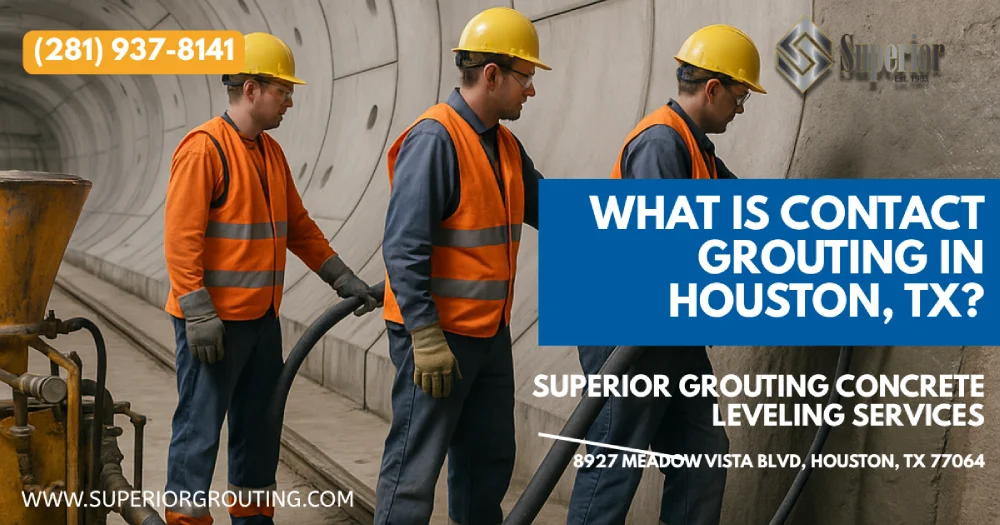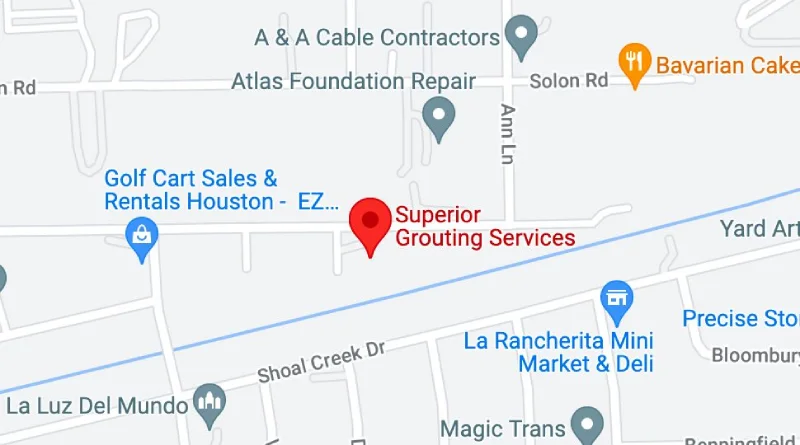What Is Contact Grouting in Houston, TX?

Contact grouting is a niche yet powerful branch of geotechnical grouting that restores intimate contact between a concrete structure and the surrounding soil or rock. In the Gulf Coast region—especially throughout Houston, TX—this service is indispensable for large‐diameter tunnels, industrial facilities, energy corridors, and heavy foundations where annular space or hidden cavities threaten structural integrity.
Unlike compaction or jet grouting, contact grouting involves injecting a low-mobility cementitious or polyurethane grout at controlled pressures to fill a void without displacing the ground. The process is efficient and cost-effective, keeps downtime to a minimum, and protects assets from settlement, water flow, and premature deterioration.
Key Takeaways
- Contact grouting restores contact between structures and soil, filling hidden voids beneath tunnels, slabs, and foundations without soil displacement—ideal for Houston’s complex subsurface and groundwater challenges.
- Low-pressure injection using cementitious or polyurethane grout allows precise void filling with minimal disruption, helping stabilize critical infrastructure while reducing excavation, labor costs, and equipment downtime.
- This grouting method prevents groundwater migration and soil erosion, extending the service life of tunnels, pipelines, and industrial foundations throughout Houston’s energy corridors and Gulf Coast region.
- Contact grouting adapts to project needs, using closed-cell polyurethane for fast lift and cement blends for deep stabilization—offering versatile solutions for both private and public sector infrastructure.
- Verification methods like thermal scans and core samples ensure quality, and hybrid techniques with permeation grouting provide additional reinforcement when controlling groundwater or sealing around utilities is essential.
Why Contact Grouting Matters for the Gulf Coast Region
Houston’s subsurface is an ever-changing mix of soft clays, sand lenses, and fluctuating groundwater. Voids form when:
- Tunnel excavation leaves an annular space between the liner and the native soil.
- Drilled shafts shrink during curing, losing side resistance.
- Washouts or utility leaks erode material under concrete slabs and pipelines.
Each void becomes a point of weakness that can magnify loads, accelerate seepage, and undermine durability. Contact grouting offers proven, scalable grouting solutions that stabilize soil, control groundwater, and keep critical corridors functioning.
How Contact Grouting Works
- Investigation
Ground-penetrating radar, probe holes, or sonar locate every cavity.
Geotechnical engineers design an injection grid that follows the path of least resistance but avoids utilities and pipelines. - Drilling
Small holes are drilled through the concrete structure or from the surface until they intersect the void.
Packers seal the borehole so grout follows only the intended path. - Injection
A cement-based slurry, epoxy‐modified mix, or polyurethane grout is pumped at low pressure (5–30 psi).
The grout fills the void, flows along the cavity, and stops once refusal pressure is reached. - Verification
Core samples, thermal imaging, or remote video confirm that all soil voids are fully occupied.
Secondary injection grouting closes any remaining pockets.
Primary Materials Used
Cementitious Grouts
Standard cement grouting uses Portland cement, fly ash, and water to achieve 1,000–4,000 psi compressive strength. Admixtures fine-tune flow, reduce bleed, and allow rapid set—ideal when heavy equipment must return quickly.
Polyurethane Grouts
Closed-cell polyurethane foam expands up to 30× its liquid volume, follows hairline cracks, and cures fast. Polyurethane injection is favored when crews must lift concrete slabs or limit water flow near critical utilities.
Chemical & Epoxy Blends
Chemical grout (acrylate or silicate) and epoxy formulate ultra-low viscosity mixes for micro‐fissures. These grouts complement but rarely replace cementitious or polyurethane grouting in Houston’s heavy civil projects.
Key Advantages of Contact Grouting
- Stabilization: Fills voids to restore the designed load path and stabilize soil.
- Durability: Cementitious and polyurethane formulations resist corrosion, sulfates, and cyclic loading.
- Water Control: By sealing annular space, grouting blocks groundwater migration and protects reinforcement.
- Cost-Effectiveness: Minimal excavation, limited downtime, and smaller crews reduce overall project costs.
- Versatility: Applicable to tunnel grouting, slab stabilization, pipeline encasement, and large‐diameter shaft collars.
Typical Applications Across Houston
Tunnel Grouting
Segmental liners beneath downtown streets rely on contact grouting to lock rings in place and prevent inflow from artesian aquifers.
Foundation Repair & Upgrade
When an existing foundation in Houston shows settlement, contact grouting—often paired with permeation grouting—re-establishes side shear and bearing without wholesale demolition.
Utility & Pipeline Corridors
Oil, gas, and water pipelines crisscross the metro. Grouting services in Houston employ cementitious mixes to fill a void around casings, preventing soil loss and maintaining structural integrity.
Industrial Facilities
Refineries and ports use polyurethane grouting to lift concrete slabs, realign machinery pads, and patch cavities created by washouts—keeping downtime and production loss to a minimum.
Large-Diameter Shafts & Shafts Collars
Heavy excavation for stormwater detention or mechanical shafts creates annular space between precast liners and soil. Cement grouting locks the liner, stabilizes soils, and controls groundwater.
Comparing Grouting Methods
| Grouting Method | Primary Goal | Typical Pressure | Soil Movement | Best Use Case |
| Contact Grouting | Fill voids, re-establish contact | 5–30 psi | Minimal | Annular space in tunnels |
| Permeation Grouting | Reduce permeability | 30–150 psi | None | Cut-off walls |
| Compaction Grouting | Densify loose soils | 200–600 psi | High | Lift structures |
| Jet Grouting | Create soil-crete columns | 2,000 psi+ | High | Underpin large diameter shafts |
Knowing which grouting services to deploy—and when—separates a capable grouting contractor from a risky one.
Why Choose Superior Grouting for Projects in Houston
- Skilled Technical Teams
Our crews average 15 years of experience in high-pressure injection and polyurethane grouting in Houston. - Comprehensive Fleet
High-output pumps, data-logging systems, and remote mixers handle everything from cement slurry to closed-cell polyurethane foam. - QA/QC Discipline
ASTM C939 flow-cone testing, real-time pressure graphs, and post-grout coring keep each cubic yard within specification. - Safety & Compliance
We meet or exceed TCEQ, City of Houston, and OSHA standards—protecting personnel, environment, and public infrastructure.
Step-By-Step Example: Contact Grouting a Utility Tunnel
- Pre-Grout Survey – Sonar mapping showed an average 2-inch annular space around a 600-ft utility corridor beneath Midtown.
- Mix Design – Engineers selected a cement grout with a plasticizer to ensure pumpability through 300 ft of hose.
- Staged Injection – Grouting involved injecting 22 cubic yards in five lifts to avoid uplifting the liner.
- Results – Settlement sensors recorded less than 0.03 in of movement, and groundwater pressure dropped 40 percent.
Common Challenges and Mitigation
- Groundwater Back-Pressure: Install weep ports and stage the grout from the deepest elevation upward.
- Unexpected Large Cavities: Keep cement grouting trucks on standby for high-volume slurry production.
- Access Limitations: Skid-mounted pumps allow teams to work from remote alleyways without obstructing traffic or other projects in Houston.
Environmental and Operational Benefits
- Reduced Excavation: No mudjacking or open-cut techniques that disturb adjacent assets.
- Lower Carbon Footprint: Contact grouting uses fewer materials compared with full replacement of concrete structures.
- Immediate Strength Gain: Fast-curing polyurethane foam allows heavy equipment to return to service within hours.
Final Thoughts
Whether you need to fill a void behind a tunnel liner, stabilize soil beneath concrete slabs, or lock a new pipeline into place, contact grouting offers a high-precision, low-risk solution. Superior Grouting combines proven grouting methods—cementitious injection, polyurethane grouting, and chemical grout additives—to deliver efficient and cost-effective results across the Gulf Coast. When structural integrity, control of groundwater, and schedule certainty matter, partner with a grouting contractor that understands Houston’s unique challenges and has the portfolio to prove it.


